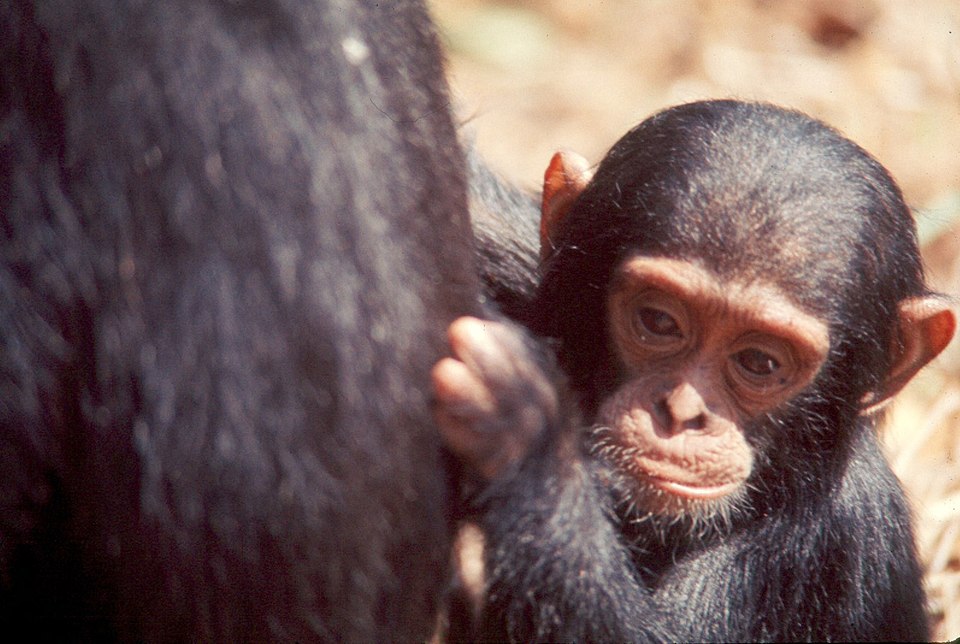File:Infant chimpanzee with adult chimpanzee - DPLA - 9da9f32d7416d8cdf57224545b95e4fc.jpg
From The Observatory
Jump to:navigation, search

Size of this preview: 800 × 536 pixels. Other resolutions: 300 × 201 pixels | 1,596 × 1,070 pixels.
Original file (1,596 × 1,070 pixels, file size: 333 KB, MIME type: image/jpeg)
This file is from a shared repository and may be used by other projects. The description on its file description page there is shown below.
Summary
| Infant chimpanzee with adult chimpanzee
( |
|||||||||||
|---|---|---|---|---|---|---|---|---|---|---|---|
| Creator InfoField | Garst, Warren, 1922-2016, photographer | ||||||||||
| Title |
Infant chimpanzee with adult chimpanzee |
||||||||||
| Description |
35 mm slide; color. Scientific Classification: Kingdom: Animalia; Phylum: Chordata; Class: Mammalia; Order: Primates; Family: Pongidae; Genus: Pan; Genus species: Pan troglodytes. Animal characteristics: Head-Body Length: 68-94 cm; Height: 120-170 cm; Weight: Males 50-70 kg; Identification: The chimpanzee has blackish hair and a lighter face that darkens with age; Habitat: Rain forests, savannas with woodlands; Diet: Omnivore: fruit, nuts, leaves, shoots, bark, eggs, insects, young animals; Reproduction: Female chimpanzees experience regular heat periods and may mate with all of the males within the troop. After gestating for 227-232 days, females give birth to one or two young which remain with them for two to three years; Social Structure: The social structure of the chimpanzee varies by location. In the forest, there are four types of social groups: 1) males; 2) females with young; 3) males and females with young; 4) males and females without young. On the savanna, chimpanzee social groups are more stable. They have at least one male, several females, and their young; Behavior: Chimps are diurnal, building nests in trees to sleep in overnight. They are very expressive and communicative; Status: Endangered; Interesting Facts: Chimpanzees are often seen using twigs and stems as tools to get termites and ants out of their nests. |
||||||||||
| Date | 1976 October | ||||||||||
| Collection |
institution QS:P195,Q110673471 |
||||||||||
| Source/Photographer |
|
||||||||||
| Permission (Reusing this file) |
This file is licensed under the Creative Commons Attribution-Share Alike 4.0 International license.
|
||||||||||
Captions
Add a one-line explanation of what this file represents
Items portrayed in this file
depicts
some value
Infant chimpanzee with adult chimpanzee (English)
35 mm slide; color. Scientific Classification: Kingdom: Animalia; Phylum: Chordata; Class: Mammalia; Order: Primates; Family: Pongidae; Genus: Pan; Genus species: Pan troglodytes. Animal characteristics: Head-Body Length: 68-94 cm; Height: 120-170 cm; Weight: Males 50-70 kg; Identification: The chimpanzee has blackish hair and a lighter face that darkens with age; Habitat: Rain forests, savannas with woodlands; Diet: Omnivore: fruit, nuts, leaves, shoots, bark, eggs, insects, young animals; Reproduction: Female chimpanzees experience regular heat periods and may mate with all of the males within the troop. After gestating for 227-232 days, females give birth to one or two young which remain with them for two to three years; Social Structure: The social structure of the chimpanzee varies by location. In the forest, there are four types of social groups: 1) males; 2) females with young; 3) males and females with young; 4) males and females without young. On the savanna, chimpanzee social groups are more stable. They have at least one male, several females, and their young; Behavior: Chimps are diurnal, building nests in trees to sleep in overnight. They are very expressive and communicative; Status: Endangered; Interesting Facts: Chimpanzees are often seen using twigs and stems as tools to get termites and ants out of their nests. (English)
some value
Reference
File history
Click on a date/time to view the file as it appeared at that time.
| Date/Time | Thumbnail | Dimensions | User | Comment | |
|---|---|---|---|---|---|
| current | 05:12, March 23, 2022 |  | 1,596 × 1,070 (333 KB) | commonsforobservatory>DPLA bot | Uploading DPLA ID 3e2d7409ddb9cda786c0c9a1251b32a1 |
File usage
The following page uses this file:

